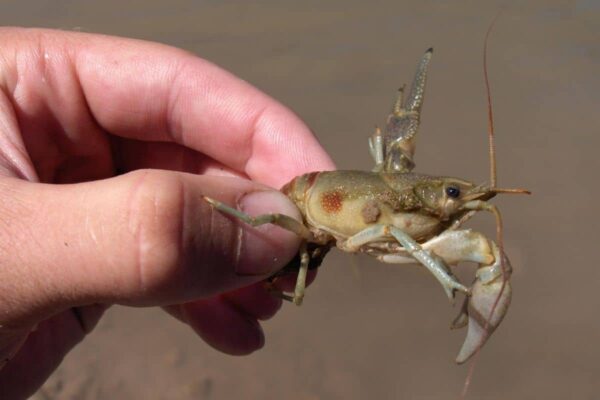Rusty crayfish
About This Species
Rusty crayfish are native to the Ohio River basin. They are not yet present in BC. They are frequently transported to new areas by fishermen in bait buckets.
Rusty crayfish are hardy and can tolerate water temperatures between 0-39 °C. They have a diverse diet and may easily outcompete native species for food and habitat. Female crayfish can carry thousands of eggs at a time, and juvenile crayfish will hold on to their mother’s tail for several weeks after hatching. Introducing a single female into a new area could have serious consequences for the aquatic ecosystems in that area. Rusty crayfish are designated as a Prevent species by the BC Provincial Priority Invasive Species List.
How to Identify
Rusty crayfish bodies range from green to gray to brown, with two rusty-red patches on the sides of their carapace. Their claws are large and have black tips. The shape of their head if distinct, they have a pinched rostrum, which gives the appearance of having a helmet over their eyes, or “angry eyebrows.”
They can reach up to 10 cm in length, but are considered mature at 3.5 cm.

Take Action
Prevention is the best approach.
-
If you need advice about invasive species on your property or you are concerned about reported invasives in your local area, contact your local government or regional invasive species organization.

Don't Let It Loose
Learn about best practices
Invasive species are plants, animals or other organisms that are not native to BC, and have serious impacts on our environment, economy and society. Never release your plants and animals into the wild or dump aquariums or water garden debris into rivers, streams, lakes or storm sewers!

Clean, Drain, Dry
Learn about best practices
The Clean Drain Dry program empowers you to help reduce the spread of invasive plants and organisms to BC waters by following the clean, drain, dry procedure on all watercraft and equipment.
REPORT TO PROTECT BC’S BIODIVERSITY

Use the app
Observe and report to protect BC’s biodiversity

Report through this website
Use our form to tell us what you’re seeing and where.



